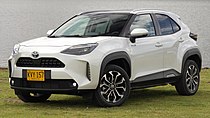The examples and perspective in this article deal primarily with North America and do not represent a worldwide view of the subject. (January 2021) |
A crossover, crossover SUV, or crossover utility vehicle (CUV) is a type of automobile with an increased ride height that is built on unibody chassis construction shared with passenger cars, as opposed to traditional sport utility vehicles (SUVs), which are built on a body-on-frame chassis construction similar to pickup trucks.
A term that originated from North America, the term crossover was initially used for any vehicle that blends characteristics between two different kinds of vehicles while, over time, crossover mostly refers to unibody-based SUVs.[1][2] Crossovers are also described as "car-like SUVs" or "car-based SUVs".[3][4][5] The term SUV is often used as an umbrella term for both crossovers and traditional SUVs due to the similarities between them.[6]
Compared to traditional SUVs, crossovers are known to be less capable of use in off-road conditions or hauling heavy loads, while instead offering other advantages such as superior fuel economy and handling.[7] Compared to traditional cars with lower ride height and a lower roof such as sedans and hatchbacks, crossovers offer larger cabin space and enhanced driving position.[8]
The 1977 Lada Niva is the world's first mass-produced unibody off-road vehicle and has been credited as a forerunner of crossovers[9] before that term was used, with the '79 AMC Eagle, being the first US example.[10] The Toyota RAV4, first introduced in 1994, pioneered the modern concept of a crossover.[11]
In the US, the market share of crossovers has grown from under 4% in 2000 to nearly 40% in 2018.[8]
- ^ "2002 Suzuki Aerio Review". NewCarTestDrive. 21 March 2002. Retrieved 17 October 2022.
- ^ Quiroga, Tony (1 January 2005). "Ford Freestyle SEL AWD". Car and Driver. Retrieved 6 June 2022.
- ^ "2000 New York Auto Show". The Car Connection. 24 April 2000. Archived from the original on 20 May 2022. Retrieved 6 June 2022.
- ^ "SUV Buying Guide". Consumer Reports. Archived from the original on 20 January 2021. Retrieved 13 February 2021.
Most car-based SUVs have modest towing capacity.
- ^ "What Is a Crossover?". cars.com. Archived from the original on 7 January 2021. Retrieved 13 February 2021.
But the "car-based" SUV models credited with breaking ground...
- ^ "5 Reasons to Buy a Crossover Vehicle". HowStuffWorks. 22 October 2018. Archived from the original on 25 October 2019. Retrieved 15 September 2019.
"Crossover" is now used almost interchangeably with "compact SUV", but some new vehicles are pushing those boundaries.
- ^ MacDonnell, Rick. "What's the Difference Between an SUV and a Crossover? Which Vehicle is Right For You?". goauto.ca. Retrieved 6 June 2022.
- ^ a b "The Rise of the Crossover: The segment that's really driving the auto industry's sales". consumerreports.org. Retrieved 6 June 2022.
- ^ "The Lada Niva: Russia's Forgotten Off-Road SUV". December 2019. Archived from the original on 26 July 2020. Retrieved 24 October 2023.
- ^ Gold, Aaron (May 2017). "AMC Eagle: No, Seriously, This Was the First Crossover SUV". autotrader.com. Archived from the original on 22 April 2019. Retrieved 15 September 2019.
- ^ Madrigal, Alexis C. (10 July 2014). "Why Crossovers conquered the American Highway". The Atlantic. Archived from the original on 4 September 2017. Retrieved 6 July 2017.


